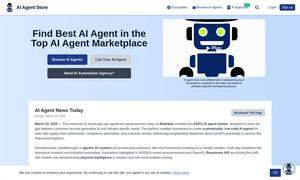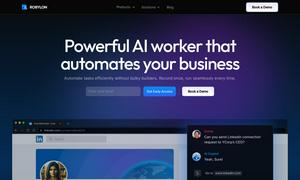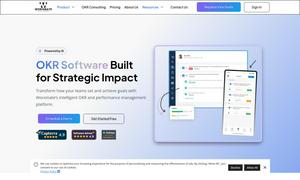
Discover the Best AI Tools to Boost Your Productivity
Find the Best AI Tools to Optimize Your Work and Personal Tasks
Best Business Automation AI Tools in 2024


What is Business Automation
The Business Automation Category encompasses tools and software designed to streamline processes, enhance operational efficiency, and reduce manual workloads. By embracing automation, businesses can improve productivity, minimize errors, and focus on strategic growth. Key benefits include cost savings, faster execution, and better data management.
How Business Automation works
The Business Automation Category works by integrating advanced tools that automate routine tasks. Typically, organizations identify repetitive processes that can be improved, select appropriate software solutions, and implement them into their workflows. Best practices involve mapping out existing processes, ensuring data security, and training staff on the new systems to ensure successful adoption and integration of the automation tools.
What are the advantages of Business Automation?
The Business Automation Category offers numerous advantages, including significant increases in operational efficiency and productivity. By automating mundane tasks, businesses can reallocate resources to more strategic areas, reduce human error, and improve accuracy in decision-making. Moreover, these automation solutions are often scalable, allowing companies to grow and adapt without overhauling existing systems.
Key Features for Business Automation
Scalability and Customization
Scalability and customization are standout features of the Business Automation Category, allowing businesses to tailor tools to meet their unique needs. This flexibility enables organizations to grow seamlessly, adapting automation processes according to changing operational demands while maintaining efficiency and effectiveness in their workflows.
Real-Time Data Analytics
Real-time data analytics is a key feature of the Business Automation Category that empowers users with immediate insights into their operations. By integrating analytics into automated processes, businesses can track performance metrics, make informed decisions quickly, and enhance overall operational effectiveness, driving better outcomes.
User-Friendly Interfaces
User-friendly interfaces are essential in the Business Automation Category, ensuring that users can easily navigate and utilize automation tools. This accessibility reduces the learning curve, allowing teams to adopt automation quickly without extensive training, thus streamlining operations and maximizing productivity from the start.
Use Cases for Business Automation?
Typical use cases for the Business Automation Category include automating payroll processing, managing customer relationship workflows, and streamlining inventory management. Organizations can leverage these tools to address specific challenges such as improving customer service response times, enhancing compliance with regulations, and optimizing resource allocation to achieve better business outcomes.
FAQs for Business Automation
How does the Business Automation Category enhance operational efficiency?
The Business Automation Category enhances operational efficiency by automating repetitive tasks, thus freeing up valuable time for employees to focus on more strategic initiatives. This leads to improved productivity, reduced errors, and the ability to scale effectively, ultimately creating a more streamlined and efficient workflow for organizations.
What unique features do tools in the Business Automation Category offer?
Tools in the Business Automation Category often offer unique features such as real-time data analytics and customizable workflows. These functionalities enhance user experience and allow organizations to tailor automation solutions to their specific needs, leading to more effective processes and better decision-making.
How does business automation improve workflow management?
Business automation improves workflow management by streamlining processes and reducing manual intervention. This results in faster task completion, fewer errors, and better coordination among team members. By automating workflows, organizations can maintain consistency and improve their overall operational performance.
What competitive advantages does the Business Automation Category provide?
The Business Automation Category offers competitive advantages such as increased efficiency, reduced labor costs, and the ability to adapt to market changes swiftly. By embracing automation, businesses can enhance service delivery, stay ahead of competitors, and foster innovation, giving them an edge in a rapidly evolving environment.
In what ways can business automation save costs?
Business automation can save costs by significantly reducing the reliance on manual labor for repetitive tasks. This leads to decreased labor expenses, minimized errors that can cause financial losses, and improved resource allocation. Overall, these efficiencies contribute to a healthier bottom line for businesses adopting automation.
How do users experience the benefits of business automation features?
Users experience the benefits of business automation features through enhanced productivity and streamlined operations. By utilizing user-friendly automation tools, they can quickly implement efficient processes, reduce task completion times, and improve communication among team members, leading to a more cohesive and effective working environment.









